Future Now
The IFTF Blog
Complexity Made Simple
What we can learn from insect coordination
How is it that termites are able to build towering cathedrals out of mud without referring to a set of blueprints? How do ants, without a leader telling them what to do, know how to assemble themselves by the thousands into living rafts to move across a fast-flowing stream? After all, the brains of ants are smaller than the “quarter of a small pin’s head,” as Charles Darwin put it, so they are incapable of planning and organizing like we are.
Social insects accomplish their complex feats of unsupervised coordination by sensing and responding to traces left on surfaces in their environment. These traces act as signals to those who come afterward, cueing them to build on the first signal. The more traces left behind, the stronger the signal becomes. For example, an individual termite might inadvertently start a new cathedral by leaving a dollop of mud on the ground. Another termite passes by and responds by adding its own dollop. The more the mound of mud grows, the more termites deposit mud on it, eventually constructing elaborate structures without anything more than a simple biological imperative—a kind of biological programming—to add to an existing bit of mud. This kind of indirect information-based coordination is called “stigmergy”.
We might think of stigmergy as a close cousin of free market economies, where individuals acting independently to satisfy their personal needs have an unplanned mass effect of promoting the welfare of the group. But there’s an important difference: stigmergy doesn’t assume rational actors who weigh the costs and benefits of taking a certain course of action. Instead it assumes millions of biologically programmed agents who instinctively respond to simple cues in their environment.
 Stigmergy is one of nature’s great tricks. Can human beings adopt stigmergy and put it to work for them? We’ll find out over the next few decades, as the Internet of Things (IoT), virtual reality, and machine intelligence create new and richly provocative ambient experiences of the world around us, laying the foundation for surprising stigmergic economies. These economies will take us well beyond the dynamics of free markets to a world where humans and machines collaborate at every scale to solve complex problems in simple ways. They will introduce us to self-defining products and services, self-assembling supply chains, and self-organizing social structures. They will emerge from a complex ecosystem of physical, digital, and mental “surfaces” to support new forms of signaling. They will use blockchains and smart contracts to translate signals into incentives for trade. Stigmergic economies may well turn today’s institutional forms into emergent games and collaborative art forms that put entertainment front and center as both humans and smart machines adapt to the rapidly changing ecosystems of the 21st century.
Stigmergy is one of nature’s great tricks. Can human beings adopt stigmergy and put it to work for them? We’ll find out over the next few decades, as the Internet of Things (IoT), virtual reality, and machine intelligence create new and richly provocative ambient experiences of the world around us, laying the foundation for surprising stigmergic economies. These economies will take us well beyond the dynamics of free markets to a world where humans and machines collaborate at every scale to solve complex problems in simple ways. They will introduce us to self-defining products and services, self-assembling supply chains, and self-organizing social structures. They will emerge from a complex ecosystem of physical, digital, and mental “surfaces” to support new forms of signaling. They will use blockchains and smart contracts to translate signals into incentives for trade. Stigmergic economies may well turn today’s institutional forms into emergent games and collaborative art forms that put entertainment front and center as both humans and smart machines adapt to the rapidly changing ecosystems of the 21st century.
Here’s how it could unfold.
Surfaces and Signals: The Building Blocks of Stigmergic Economies
Termite cathedrals start with a single surface. Stigmergic economies start with massively many surfaces for leaving signals. Beyond mud droppings that add up to termite cathedrals or pheromones that create the instruction set for armies of ants, today’s digital world has thousands of new surfaces for individual actors—humans or machines—to leave their daily marks. Other actors read those marks as signals and build on them, often creating new value. For instance, they remix media and fork code. They set the value of a song by downloading it. They build communities and global movements with simple memes that get replicated, reinterpreted, and rehashed to build group identities that people may be willing to die for.
In the coming years, these surfaces for signaling will dramatically proliferate as the digital world is embedded ubiquitously in the physical world. The IoT will turn billions of physical objects into new surfaces for signaling—from microscopic plaque-clearing circuits inserted into human arteries to sensors on self-driving trucks.
Imagine a stigmergic ecosystem within the rivers that flow through the world’s famous cities. A duck sheltering in the underbrush at the edge of the Hudson might leave a dropping that a genetic sequencing sensor the size of a thumb drive (like Oxford Nanopore’s tiny DNA sequencer, the MinION) would automatically detect and analyze, transmitting the result on an internet of living things (like Oxford Nanopore’s Metrichor cloud service for real-time molecular analyses), where artificially intelligent algorithms have learned to recognize early permutations of the H1N1 virus. These algorithms, in turn, alert not only scientists and the Centers for Disease Control, but anyone who is fishing with an Internet-connected fishing reel or incubating chicken eggs with an Internet-controlled sensor—all without a director of public health or CNN to get the message out.
As matter of all kinds, from barrels of olive oil to piping hot pizzas, is routed efficiently to its destination with autonomous vehicles, both the shipments and vehicles become smart surfaces where ratings, monetary value, health value, bacterial genetic data, traffic density reports, and other crowdsourced markers can be recorded, amplified, and incorporated into other information flows. And the crowd in this case is not necessarily the human crowd at all. It’s a lot of smart, connected devices getting socialized through stigmergy—each usingdigital traces to activate its next move.
The results are likely to span the spectrum from triumph to catastrophe. Smart algorithms might respond to millions of bio-signals to anticipate the need for precision drugs and protocols in a Zika-infested region. But they might just as easily conjure euthanasia “services” that fall prey to the Tay-bot syndrome, learning the worst that the crowd, both human and non-human, has to offer.
Still, an instrumented IoT is just the tip of the iceberg for new signaling surfaces and the value exchanges they can create. Even as the great onboarding of connected devices unfolds, the coming decade will usher in 3D immersive virtual realities to incorporate these objects into their imaginative worlds. They will turn sensor-laden mechanical pencils into scalpels in virtual operating rooms or conductor’s batons in a global symphony of a million instruments. Every virtual reality will be a new surface—an ecosystem of surfaces, really—where people and things can collaborate via traces, markers, and signals that add up to much more than any individual programmer, product designer, or marketing director could imagine.
Eventually these ad hoc collaborations of signals will cross the boundaries of individual virtual realities, creating what science fiction authors have perhaps imagined as inter-dimensional networking: communication across parallel realities. They may even cross the boundaries of the mental realities as neuroscience turns the human brain into a read-write surface.
Bitcoins and Blockchains: The Incentives of Stigmergic Economies
Of course, signals alone do not guarantee economic coordination or cooperation. In the world of massively many new signaling surfaces, the resulting flood of signals could just as easily breed chaos as it could self-organize supply chains. Every stigmergic system depends on attention to the marks or traces that stimulate successive actions. Often this attention is hardwired into the individual actors: termites are biologically wired to look for piles of mud where they can deposit their own contribution. But in most human systems, extrinsic incentives enter into the equation. And the most pervasive incentive is money.
 Cue the blockchain. The distributed computing model of the blockchain has already given rise to Bitcoin as a fungible and scalable digital currency. Crudely stated, Bitcoin miners take the place of Wall Street speculators, making their money by paying attention to billions of individual transactions—”signals”—and verifying their accuracy in the Bitcoin ledger. The verification service they provide through the distributed tracking of transactions takes the place of centralized banks and their computers. It enables rapid trade between individuals and across organizations, and even global borders.
Cue the blockchain. The distributed computing model of the blockchain has already given rise to Bitcoin as a fungible and scalable digital currency. Crudely stated, Bitcoin miners take the place of Wall Street speculators, making their money by paying attention to billions of individual transactions—”signals”—and verifying their accuracy in the Bitcoin ledger. The verification service they provide through the distributed tracking of transactions takes the place of centralized banks and their computers. It enables rapid trade between individuals and across organizations, and even global borders.
Meanwhile, dozens of organizations are experimenting with blockchain architectures as a way to create other kinds of incentives for participating in a stigmergic economy—that is, to share data via wallets, smart contracts, and so-called oracle services. These incentives encompass the traditional human incentives like learning, good health, entertainment, access to resources, and ultimately personal reputation, all of which can be represented and traded on the blockchain.
The blockchain has the potential to make these kinds of values as tangible and perhaps as fungible as money. For example, in early 2016, IFTF convened thousands of gamers in a “Learning Is Earning” game. The goal was to imagine how a blockchain ledger might be used to validate learning, especially learning acquired through the performance of microwork or community tasks. Every dollar earned in certain tasks might be translated into a learning credential, which in turn, could command more dollars on the next gig.
Incentives don’t have to be human incentives, however. They can simply be programmed goals and objectives. Autonomous vehicles might be programmed to maximize their fuel budgets, with intelligent algorithms that track real-time pricing for electricity along their travel routes and even balance selling spare charge versus taking on passengers to achieve the best fuel outcomes. These “decisions” by the vehicles, captured in digital records on the blockchain, might in turn trigger the algorithms of smart grids to balance demand across entire regions by incentivizing new rhythms of energy use. These rhythms may ultimately redefine the workday the way the automobiles of the 20th century led human managers to adopt a fixed 9-to-5 workday. A “hive” of algorithms might even self-organize to create DACs and DAOs: distributed autonomous corporations and organizations that aggregate functions, resources, people, and objectives using stigmergic signals, complex incentive structures, and the blockchain.
Games and Art: The Organizing Structures of Stigmergic Economies
 Smart machines, smart matter, and smart algorithms will undoubtedly do a lot of the heavy lifting in stigmergic economies, responding to small signals to carry out minute distributed tasks guided by diverse incentives. And as they self-organize into DACs and DAOs, they are likely to create landscape-changing patterns of organization that might never occur to any CEO, business school brainiac, or international trade negotiator.
Smart machines, smart matter, and smart algorithms will undoubtedly do a lot of the heavy lifting in stigmergic economies, responding to small signals to carry out minute distributed tasks guided by diverse incentives. And as they self-organize into DACs and DAOs, they are likely to create landscape-changing patterns of organization that might never occur to any CEO, business school brainiac, or international trade negotiator.
To anticipate this new landscape of organizational structures, look at the cutting edge of today’s so-called procedural games like “Minecraft” or “No Man’s Sky”. These games start from a single seed—you might think of this as a stigmergic signal—and use algorithms to spawn entire universes. “No Man’s Sky” offers up to 18 quintillion planets to explore, each with unique life forms that evolve from the single seed that sparks it. The algorithms mimic biological evolution to create distinctive creatures—artfully rendered in high resolution—from the seed DNA of each planet.
Now imagine that every signal on every surface in the future world of ambient machine intelligence is a seed for a game—for a physical-digital universe that both humans and machines can explore, shape, and share. This is the future of stigmergic economies: a vast and endless gamescape. In this gamescape, people play with biomimetic agents of all kinds to simulate quintillions of biomimetic worlds. It’s easily a gamescape scaled for a global economy of a mere 8 or 9 billion humans.
Ultimately, such stigmergic economies are well suited to times of rapid and potentially devastating changes in the planetary ecosystem. These are times when forking and mixing, replicating and iterating can generate the novel biological, social, and digital life-forms that enhance evolutionary adaptation. Selection speeds up at times like these, and stigmergic economies offer the palette of surfaces, the innovative incentives, and experimental structures to adapt more rapidly. They promise to try out all possibilities and uncover those that offer the most resilient future. Ultimately, this may be what stigmergic economies are all about—building resilience into the coming worlds of biomimetic machines.
 FUTURE NOW—When Everything is Media
FUTURE NOW—When Everything is Media
In this second volume of Future Now, IFTF's print magazine powered by our Future 50 partnership, we explore the future of communications, tracing historical technology shifts through the present and focusing on the question: “What is beyond social media?”
Think of Future Now as a book of provocations; it reflects the curiosity and diversity of futures thinking across IFTF and our network of collaborators. This issue contains expert interviews, profiles and analyses of what today’s technologies tell us about the next decade, as well as comics and science fiction stories that help us imagine what 2026 (and beyond) might look and feel like.
About IFTF's Future 50
Every successful strategy begins with an insight about the future. Every organization needs to build the capacity to anticipate the future. The Future 50 is a side-by-side relationship with Institute for the Future; it’s a partnership focused on strategic foresight on a ten-year time horizon. With 50 years of futures research in society, technology, health, the economy, and the environment, IFTF has the perspectives, networks, signals, and tools to make sense out of the emerging future.
For More Information
For more information on IFTF's Future 50 Partnership and Tech Futures Lab, contact:
Sean Ness | sness@iftf.org | 650.233.9517



